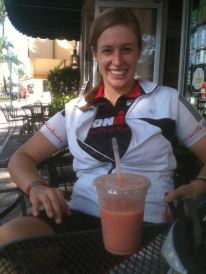
“We are all capable of so much more than we think we are. When we put ourselves out there and we risk failure, and we do things that other people call “crazy,” that is when we find true joy and a sense of accomplishment.”
Those powerful words come to us from 29 year-old elite endurance athlete Kacie Darden, half of a two-woman cycling team that will attempt to set the two-woman team record at the famed 3,000-mile Race Across America (RAAM) this June (you can read partner Dani Grabol’s interview here).
Kacie took time away from her hectic training schedule (read on to get a taste), husband, and full-time job to share more about her journey from first-time duathlete to double Ironman (4.8 mile swim, 224 mile bike, and 52.4 mile run, which she did in UNDER 29 hours!)–in just four short years!
Read on and I know you’ll be inspired–and if so, please make a donation to the charity they’re racing for. It’s Camp Twin Lakes, a network of camps for kids with disabilities, illnesses, and other challenges–here. And check THIS out–donate $25 to sponsor one of their RAAM time stations and you’ll get a personal text from the team telling you how they’re doing when they hit it! Check out details here.
Many thanks to Kacie for sharing your story!
You took on your first endurance event–a duathlon–just five years ago at the age of 24. What made you decide to enter that very first race? Were you that fitness-oriented beforehand?
 I entered my first race the year my husband, George, and I got married. I could tell after we got married that he felt like something was missing from his life. He was working full time and in the middle of his PhD program, and seemed a little lost. I asked him what was missing, and after thinking about it, he said, “racing.” He was a collegiate runner, and time had gotten the better of him. So, I started looking around on the internet, and found a duathlon.
I entered my first race the year my husband, George, and I got married. I could tell after we got married that he felt like something was missing from his life. He was working full time and in the middle of his PhD program, and seemed a little lost. I asked him what was missing, and after thinking about it, he said, “racing.” He was a collegiate runner, and time had gotten the better of him. So, I started looking around on the internet, and found a duathlon.
I came home and said, I’ll do it if you do it! He looked at me like I was crazy! I have always loved adventures, but I had never raced before. I bought a flat handlebar commuter bike and a pair of running shoes. I LOVED it. At the finish, I decided that I would start swimming and do triathlon, and he went into bike racing. Since then, we have switched, and he focuses on triathlon and me on bike racing! The most important part of it for me is that he and I are a team. We support each others’ goals. We cheer for each other at races. There’s a lot of compromise and give and take. Right now is my time to really train for RAAM, and he does everything he can to help me achieve that. Before that, the real focus was his racing at the Ironman World Championships in Kona.
Since 2008 you’ve completed four Ironman races, a DOUBLE Ironman in under 29 hours and even won a 50K trail running race. Did you ever imagine, when you entered that first race, that it would develop into such a passion and that you’d go on to accomplish so much?
When you say it that way, it feels like a really big deal! No, I never imagined that…..BUT I have never been one to do anything halfway. Ever. I always jump into things head first. I am not much of a “dabbler.” I think that it is really my mind that is made for endurance sports. I don’t think you would pick me out of a lineup as the ultra endurance athlete. I really do not see it when I look at myself. My my mind is very strong, and I am an incredibly determined person. I struggle with moderation! This is a healthy way for me to channel that kind of intense focus that I tend towards.
Were you athletic growing up? What sports did you enjoy?
Funny enough, I was also a high school cheerleader [like cycling partner Dani]. To be honest though, school was my sport! I did debate, mock trial, math team, academic bowl, and volunteering. I loved school, and I was very succesful, and I worked incredibly hard (refer to that lack of moderation thing above!).
I have always loved being outside. My BS and MS are in Ecology, so I spent a lot of time hiking and camping in beautiful places.
When did you start cycling?
I certainly used my bike as a way to get around as a kid, but never raced it. I did love going down steep hills in my neighborhood, and I love decending down mountains today! I started cycling right before that 2008 duathlon.
You’re not only an accomplished endurance athlete with a busy training schedule but also have a “day job” as a middle school science teacher and a husband who no doubt likes to see you every once in a while. How do you find time to fit it all in?
It’s true, I do have a day job. I am lucky enough to teach at a very supportive school. I coach cross country in the fall, and all of my kids know about my adventures and they cheer for me. In the double Iron, they sent me a video that I watched in one of the 10 minute breaks that I took. It was incredibly uplifting!
If you are getting into these sports, it’s all about balance and efficiency. Finish your work at work, use every minute, and set your alarm early. My alarm goes off between 4:30-5 AM every day. I try to be very careful about how I use my time. By the time you get to the level that Dani and I are racing, it is no longer about balance, it is about total commitment to your goal. Other things do have to take a backseat, and that is ok. My friends know what I am doing, and they know that they will spend more time with me in July.
I do love spending time with my husband though. We make sure that some of the things we have to do anyway, we do together, like weekly grocery shopping. I see my husband on the bike. We talk on the phone as we are driving to work in the morning after my workout and his masters swim. He joins the last 1.5 hours of my Tuesday and Thursday rides. Some of my rides are in the night so that I can do what I need to do during the day. There are no shortcuts, but there is good planning and preparation.
You’re less than five months from the start of Race Across America, a 3,000-mile bike race where you’ll attempt to be part of the youngest 2-person female team ever to finish the race–and only the third 2-person female team to ever do so. What made you decide to tackle this famous race–and to do it as part of a two-woman team?
Less than five months! Holy cow, I need to get back to pedaling!
I did this race last year as an 8 person team. I joined it in the last month of planning, so I wasn’t a part of the entire process. It was certainly an adventure, but it wasn’t the best experience. The riding was incredible, but there was a great deal of friction inside of the team. When I got to Annapolis, I knew I wanted to do it again on two conditions: 1. I wanted to ride more. 2. I wanted to be at the foundation of the team and not thrown in at the end.
What’s your typical training day like these days? Training week? At your peak, how many miles will you ride in a single week?
Well….it’s tough!
Monday: Morning strength training. I am working with a fantastic trainer who is very focused on endurance athletes and the issues that I need to focus on, such as my back and my neck (areas that can fail on very long rides). Monday afternoon is my day to get my allergy shots (I am asthmatic), get massage if I can get in, or see my chiropractor. I think of it as a therapy afternoon!
Tuesday: Morning I get on the trainer for an hour. Right now, I get to do whatever I want to do on it, and watch some TV.
PM is tough. Before the time changes, and I have light, I am on the trainer. It ranges from 3.5 hours up to 5 hours. The last hour and a half is an intense and very structured workout.
Wednesday: Morning I meet Dani at an indoor cycling studio in Atlanta called Energy Lab, and I ride for 1.5 hours in a semi-structured workout.
PM is cross training–yoga, running, or swimming.
Thursday: Just like Tuesday. Morming hour on the trainer, and a hard PM 3.5-5 hours with the last 1.5 hours being very structured.
Friday: Morning Strength Training PM fall into bed as soon as possible
Saturday: This is where it gets tricky! For the next few weekends, I have 6 hour rides, with three hours in the dark (with my husband in the car behind me). Occasionally, I will do a very long ride (like 12 hours). Other times, I will do on/off workouts (1.5 hours on with 1 hour off all day long).
Sunday: This is becoming my climbing day. I drive to our nearest mountains and ride up as many as I can fit in in about 6 hours.
How did you create a training program that works for you and your schedule?
I have a coach (Will Dillard) who has coached me through all of my events. We are very collaborative, and we communicate a great deal about my training and my progress. There is no guidebook for two person RAAM though!
I have to ask: how many calories do you eat a day? How many calories will you eat a day during RAAM, and what will you eat?
Good question! I am not really sure! I do not eat meat except for fish, and I eat about every 2-3 hours. I actually struggle counting calories (I can become a little obsessive and unhealthy), so I work with a sports nutritionist who does not have me counting any. I am still working on my nutrition plan for RAAM. It’s tough, becuase you have to start learning how to eat real food, and then ride. In a 9 day event, you cannot rely entirely on sports nutrition to get you through it. That being said, I take in about 200-300 calories an hour on the bike.
There must be days when you just don’t feel like working out, or want to sleep in when you have an early workout on the schedule. Where do you find the motivation to push past the negative thoughts, get out there and get it done?
It really is all about that first step. Yes, there have been days, and there will be days, when doing the work is the hardest thing to do. I always have early workouts, so it becomes my normal and it is just my reality. For me, sometimes getting on the bike in the afternoon after a day of working and a morning workout is the hardest. I do find though that once you get going, it’s always ok! I also think that you have to be prepared to have one bad workout a week. Sometimes it just doesn’t click, or your head’s not in it, or you just don’t feel good. It doesn’t matter though. Your body doesn’t know you weren’t “feeling it,” your body still got the workout in, and you are one step closer to your goal.
I imagine that some of the biggest challenges–both in training and RAAM itself–are riding in bad weather, saddle sores, and the struggle to maintain focus during the race when you’re so exhausted. How do you deal with the first two and how do you prepare for the third in training?
Bad weather: my coach says that you can’t control anything except your attitude. You certainly can’t control the weather! I think that so much of our training is preparing us for the weather. We will train in hot and cold. I just finished 5 hours in demoralizing wind. Honestly, when you train as much as we do, you end up riding in all kids of weather. What you ultimately have to work on is your mindset and your ability to relax and stay calm when mother nature turns against you.
Saddle sores: I have been working diligently with a bike fitter leading into RAAM. We have changed saddles and position as I spend more time on the bike and develop issues. That being said, you don’t know how bad it will get until you are actually on RAAM. We will do our best to prevent saddles sores before they arrive by changing our shorts frequently, and then dealing with them once they come.
 Exhaustion is a major issue in RAAM. First and foremost we want to reach Annapolis in one piece and for our crew to be safe as well. There is no way to truly simulate the kind of fatigue that you will feel on RAAM without being on RAAM. We will both do some overnight riding to prepare. We will go to the edge of our fatigue level during training, but we will have to face those issues when they arise in the race, and hopefully, our crew will help us pull through them safely.
Exhaustion is a major issue in RAAM. First and foremost we want to reach Annapolis in one piece and for our crew to be safe as well. There is no way to truly simulate the kind of fatigue that you will feel on RAAM without being on RAAM. We will both do some overnight riding to prepare. We will go to the edge of our fatigue level during training, but we will have to face those issues when they arise in the race, and hopefully, our crew will help us pull through them safely.
A bit on race logistics: What kind of bike will you be riding? What kind of support will you have on the course?
I will have my time trial bike and my road bike. I will have three sets of wheels per bike of varying types (disc, 808’s, 404’s, training). We will have 10 crew members and 3 vehicles.
You’ve tackled RAAM before as part of an 8-person team. What do you anticipate will be the most difficult part of the race as part of a two-person team? What are you looking forward to the most?
I think that the lack of sleep is going to be the hardest part. On the 8 person team, we were done in 6 days, but this race will be two more days and a lot more miles. I think those extra days without much sleep will be very difficult. I look forward to feeling like we have really done it as a team. Finishing with our crew satisfied with the accomplishment is important to me too. Without proper teamwork, crews can hit the pier in Annapolis and no longer want to be friends. I want my crew jumping for joy and toasting with champagne at what an amazing job we all did. Then, I want a fluffy bed.
Many casual gym-goers adhere to that “no pain, no gain” philosophy of going all out every workout. What can they learn about recovery and rest from a competitive endurance athlete like yourself?
A great deal of my training is at a moderate intensity level. When I increase intensity, I have to increase my recovery time. I think it is important to remember that what you do between workouts can matter even more that what you do during the workout. Eating right, drinking plenty of water, and getting enough sleep are the keys to recovery. Granted, these are not the most exciting parts of training for a goal, but they can be the most important. I also think that if something starts to hurt, athletes like us go see a professional quickly. We both work with chiropractors, massage therapists, doctors, physical therapists and more. I think that the average athlete could benefit from this too. Professionals can tell you when you are about to be injured, you are injured, or if you just need a little rest. We are not afraid to ask for help.
Let’s talk about your RAAM racing partner, Dani Grabol. Her story is incredibly inspiring: once overweight, she’s told by her doctor that if she doesn’t lose weight she might not see her 40th birthday. She gets into triathlons to lose weight only to be injured in a serious car accident. She perseveres, eventually finishing second among women and fourth overall in a double Ironman, and becomes the fastest woman ever to cross Florida on a bike. Finding a training partner for something as big as RAAM can be a huge decision and commitment. How did you and Dani meet and how did you know that she was the right partner for this undertaking?
Dani is incredibly, and I am so lucky that she agreed to pair with me for this journey. Dani and I met when we were both training for the double Ironman. We got the chance to train together some, and I knew quickly that we were kindred spirits. During the race, we were on a 0.85 mile out and back run for 54 miles. I got to see her over and over again. I was so impressed by her focus and determination. Even though she was beating me, I really was cheering for her! I was incredibly proud of her effort, and we stayed in touch. When I did 8-person RAAM, Dani followed my efforts and sent me lots of cheers through texts, emails, calls, and Facebook. Standing on the pier at the finish line in Annapolis, I was sure I wanted to do it again, but this time, with my own team, and fewer people. It only took a couple of emails with Dani in the week after RAAM last year, and our team was born!
You’re doing this race to raise money for a wonderful organization: Camp Twin Lakes, a network of camps in Georgia for children with disabilities, serious illnesses and other challenges. How did you select this organization in particular? How can people sponsor you with a donation?
I have been involved with Camp Twin Lakes through their cycling fundraiser, Spin for Kids. One of my best friends and one of our sponsors, Laura Barnard, is on the board of CTL. In spending time at CTL, I fell in love with the place. As a teacher, I have a very soft spot in my heart for kids–teaching them is truly my calling. Camp Twin Lakes provides and experience for kids with disabilities, illness, and other challenges that they would not otherwise experience. I spent a day at camp this summer when they were having camp for kids with kidney disease. The kids were alternating between dialysis and a zip line–and I love that. People can donate to our website for Camp Twin Lakes at www.raam2013.org.
To err is human. Over the years training for and racing in endurance events, what mistakes have you made and what lessons have you learned from them?
Stay calm–it will get worked out. For me, sometimes I just need to stop for a minute, think about the best solution to the problem, solve it, and move on. I think that preparing yourself mentally is as important if not more important than preparing yourself physically. Figure out your fears and your weaknesses, and work on them. Turn them around and use them to your advantage.
How has participating in endurance sports contributed to other parts of your life?
I love working towards a goal. Having something to aim towards and focus on every day gives me focus and determination. An unexpected part of endurance racing for me has been the friends that I have made. When you train together, you spend hours side by side talking. It is amazing what you can learn about a person after 100 miles on a bike together. It has also made my marriage stronger. We both race, and because of that we literally both get to cheer for each other at races. Having the opportunity to tell my husband that I am proud of him and he is proud of me makes us stronger and our relationship is deeper.
What advice would you give to someone who’s thinking of training for their very first endurance event–be it a sprint triathlon or century ride?
Don’t be afraid of failing. When you work towards a goal that seems just out of reach, your accomplishment feels even better. Take the leap of faith and do it. I also think it helps to build a support system of friends and family around you. Remember that the race itself is just the cherry on top of training.
After all you’ve done–and after RAAM–what’s left on your to-do list of endurance events?
It’s hard to imagine anything after RAAM. I mean, even the next day. I feel like my whole life is so focused on this one goal, that it’s tough to imagine moving on. Alas, time always passes, and I’ll find myself in Annapolis thinking about what’s next. There are so many things I would love to do! 24 hour bike racing sounds exciting to me. I would love to do a little more ultra-running. I have a plan to swim the English Channel one day, but I don’t really like the cold, so I am in no rush on that one! I like races that capture my imagination, so once I am done, I will start thinking about the next one. I also want to have children, and I hear that is an endurace race in and of itself!
What the heck does the last hour of a DOUBLE Ironman feel like? The final mile? Are you emotional, elated or just too exhausted to feel anything?
 I had a great race at the double. My pacing plans were impeccable, and I never slowed down. Each of my laps was so close in time to the others that my crew started calling me “the metradome.” I had quite a few friends who accompanied me during the run portion. It was great to have friends telling me stories, and reading emails/texts/Facebook posts from friends and family at home who were cheering me on.
I had a great race at the double. My pacing plans were impeccable, and I never slowed down. Each of my laps was so close in time to the others that my crew started calling me “the metradome.” I had quite a few friends who accompanied me during the run portion. It was great to have friends telling me stories, and reading emails/texts/Facebook posts from friends and family at home who were cheering me on.
One of my last friends to join me was Scott Rigsby, who was the first double amputee to finish the Ironman World Championship in Kona. He is an inspirational speaker and author for a living now. First, he talked to me about anything, music, friends, family. Then, he started giving me my very own inspirational speech. He told me that I would always have this accomplishment once I got through it. He reminded me to share and feel gratitude in this accomplishment with my husband and my friends who gave so much for me to finish. He was running next to me, with no legs mind you, telling ME what an inspiration that I am.
 I was in tears by the end, and switched out running with my husband for my last lap. I told George that I was crying happy tears, not sad ones, and that I was just so excited to be finishing and how much I appreciated him. We had a great last 1.6 miles together, and when I was done, I collapsed into happy tears with some of my closest friends around me. It was a really wonderful day. We are all capable of so much more than we think we are. When we put ourselves out there and we risk failure, and we do things that other people call “crazy,” that is when we find true joy and a sense of accomplishment. I am just lucky that I have the support and ability to have found this part of my life.
I was in tears by the end, and switched out running with my husband for my last lap. I told George that I was crying happy tears, not sad ones, and that I was just so excited to be finishing and how much I appreciated him. We had a great last 1.6 miles together, and when I was done, I collapsed into happy tears with some of my closest friends around me. It was a really wonderful day. We are all capable of so much more than we think we are. When we put ourselves out there and we risk failure, and we do things that other people call “crazy,” that is when we find true joy and a sense of accomplishment. I am just lucky that I have the support and ability to have found this part of my life.
Do you two have compatible strengths on the bike for RAAM? For example, is one of you stronger on flats and the other stronger on the hills?
It’s funny that we just finished really talking this out together. I think that ultimately, Dani is faster than I am. I am more durable than Dani is. Together, we are going to make an incredible team. We are going for the overall female two person record, and I think that we are just the right combination of speed and endurance to do it.
How much are you two able to train together?
We train together as much as we can. We always train together on Wednesday mornings at cycling studio. We often have a meeting together each week with a sponsor or our crew. We also try to do weekend rides together when we can and when our schedules work out.
Last but not least: how can people both follow your training and follow along and cheer for you and Dani while you’re racing RAAM?
Like our Facebook page, Power, Pedals, and Ponytails. Follow us on Twitter! @powerponytails. Our team blog is www.powerpedalsandponytails.blogspot.com and my personal blog is www.kacietri-ing.blogspot.com

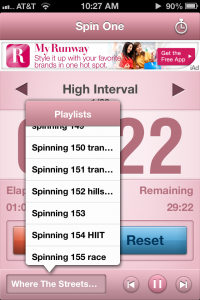 “high interval”–hill repeats, sprints, surges, out of the saddle climbs, etc–or you can mix it up from rep to rep. The app also allows you to select different sound effects–chimes, boings, boxing bells–to indicate when you’re supposed to switch, so you don’t have to constantly watch the screen–which means you can use it while running, on the Stairmaster, elliptical, etc. Want to use it on a run while playing tunes on your iPhone? No problem: you can even select playlists and control them within the app.
“high interval”–hill repeats, sprints, surges, out of the saddle climbs, etc–or you can mix it up from rep to rep. The app also allows you to select different sound effects–chimes, boings, boxing bells–to indicate when you’re supposed to switch, so you don’t have to constantly watch the screen–which means you can use it while running, on the Stairmaster, elliptical, etc. Want to use it on a run while playing tunes on your iPhone? No problem: you can even select playlists and control them within the app.
 If one word summarizes the last year and a half for me, it’s transition. In that time I’ve left a job where I’d worked for nearly 14 years, launched my own business, moved in with my man, and–in the past two months alone–sold my condo and moved 500 miles from Washington, DC (my home of over 15 years) to Knoxville, TN.
If one word summarizes the last year and a half for me, it’s transition. In that time I’ve left a job where I’d worked for nearly 14 years, launched my own business, moved in with my man, and–in the past two months alone–sold my condo and moved 500 miles from Washington, DC (my home of over 15 years) to Knoxville, TN.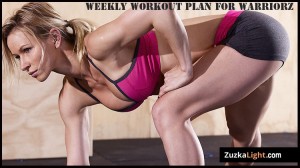
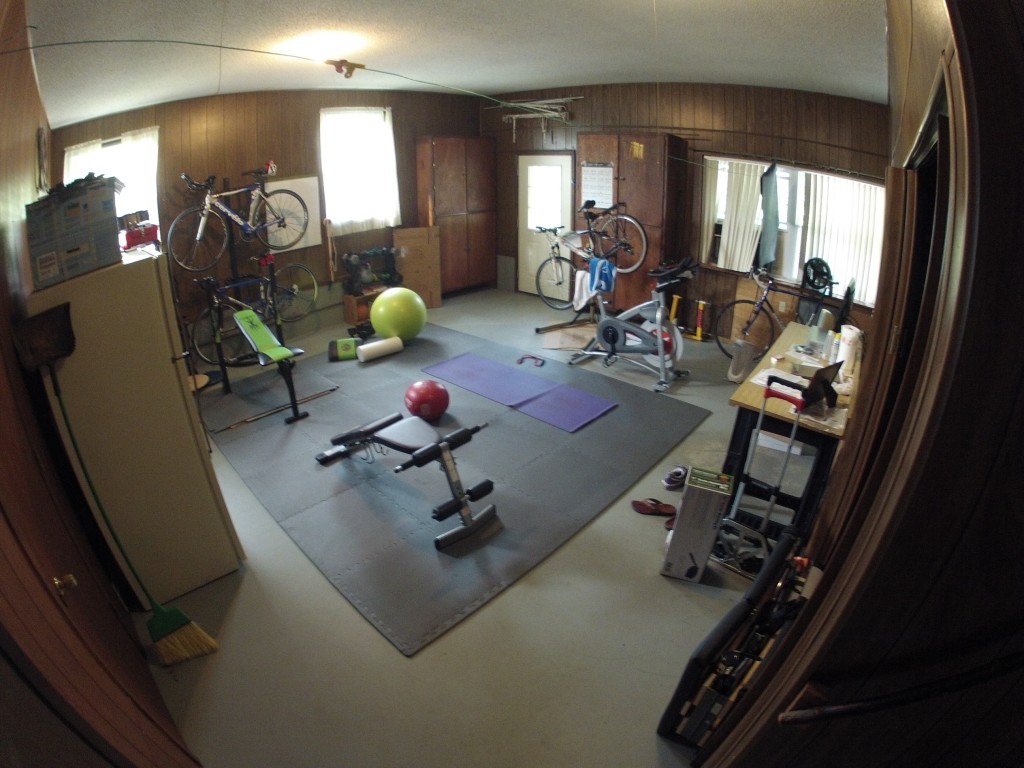
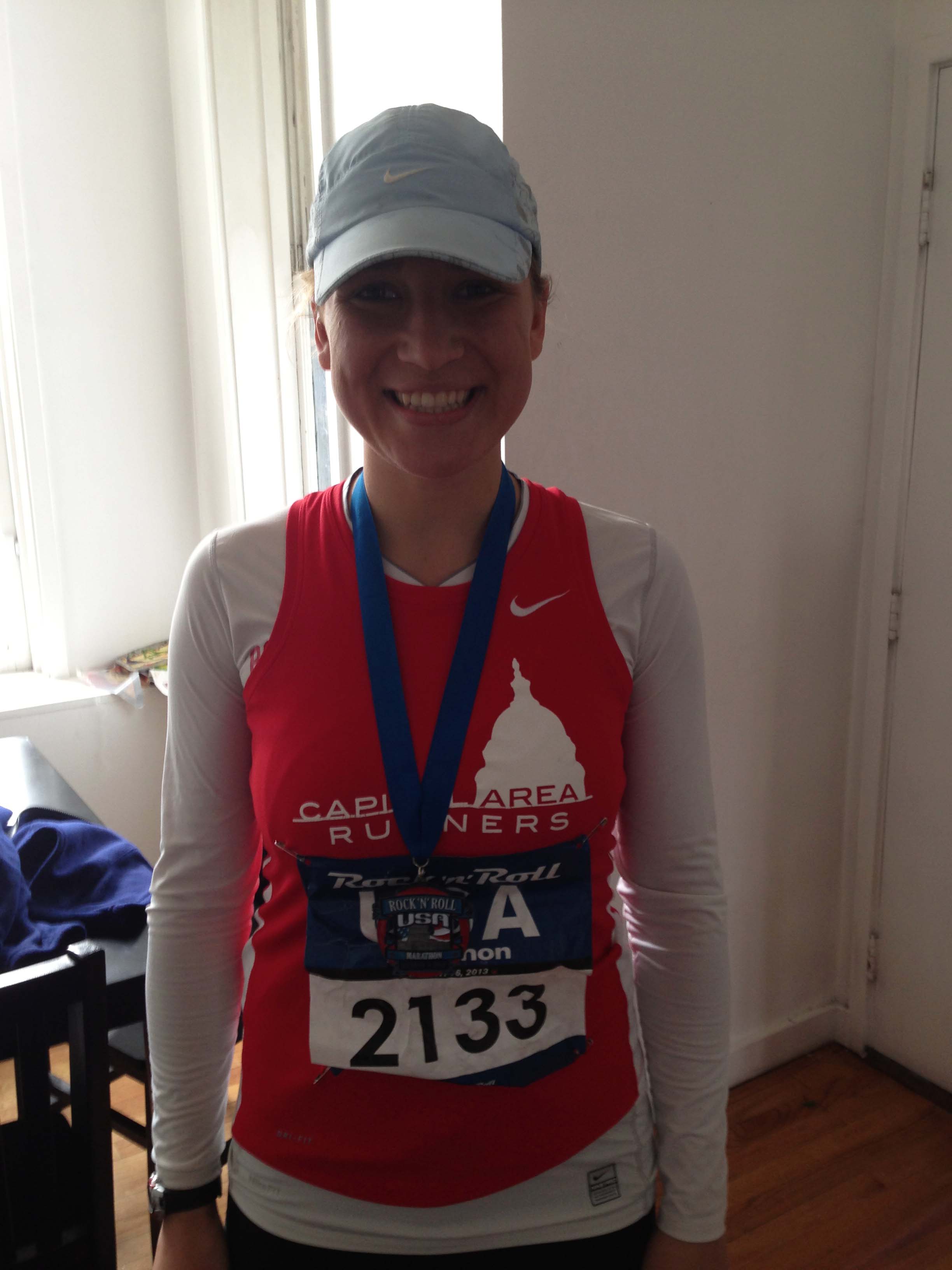
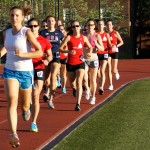 I started running in Junior High track, and then continued to run (not particularly seriously or well) through high school cross country and track. I didn’t want to do “distance” in track and instead ran the 800m and the 300 hurdles. (At the time I was much more focused on downhill ski racing, which I did pretty seriously until college.)
I started running in Junior High track, and then continued to run (not particularly seriously or well) through high school cross country and track. I didn’t want to do “distance” in track and instead ran the 800m and the 300 hurdles. (At the time I was much more focused on downhill ski racing, which I did pretty seriously until college.)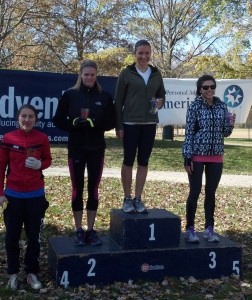 Since you moved to DC you’ve won more than a few races, no? Brag a little!
Since you moved to DC you’ve won more than a few races, no? Brag a little!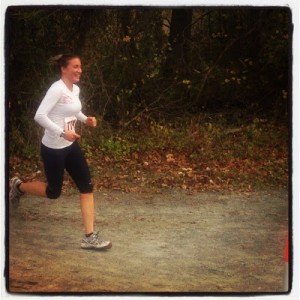
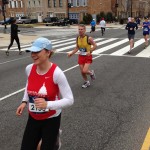




 I entered my first race the year my husband, George, and I got married. I could tell after we got married that he felt like something was missing from his life. He was working full time and in the middle of his PhD program, and seemed a little lost. I asked him what was missing, and after thinking about it, he said, “racing.” He was a collegiate runner, and time had gotten the better of him. So, I started looking around on the internet, and found a duathlon.
I entered my first race the year my husband, George, and I got married. I could tell after we got married that he felt like something was missing from his life. He was working full time and in the middle of his PhD program, and seemed a little lost. I asked him what was missing, and after thinking about it, he said, “racing.” He was a collegiate runner, and time had gotten the better of him. So, I started looking around on the internet, and found a duathlon.


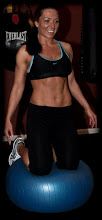 Dani Grabol once weighed 225 pounds and was a pack-a-day smoker.
Dani Grabol once weighed 225 pounds and was a pack-a-day smoker.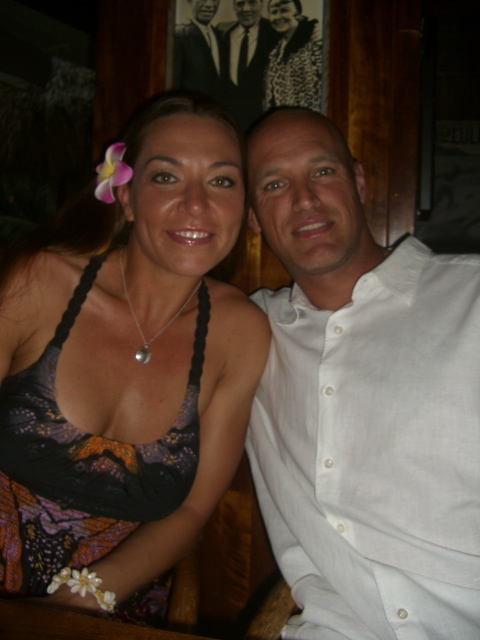
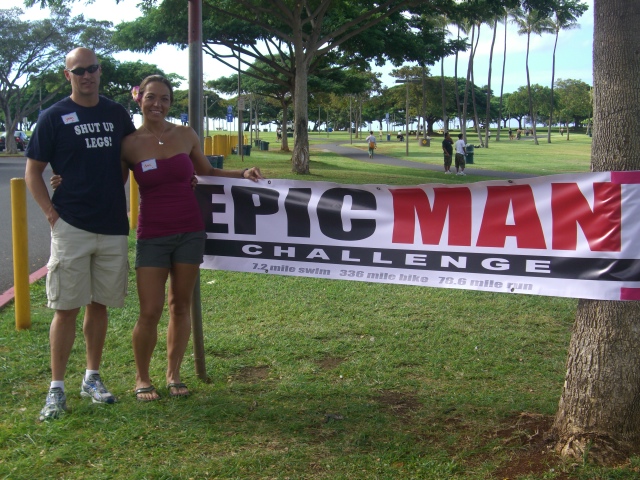
 Great job to the Thursday Spinning class on hitting those High Intensity Intervals today!
Great job to the Thursday Spinning class on hitting those High Intensity Intervals today!